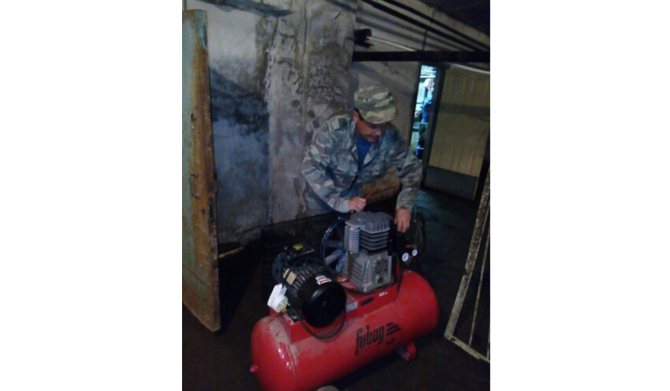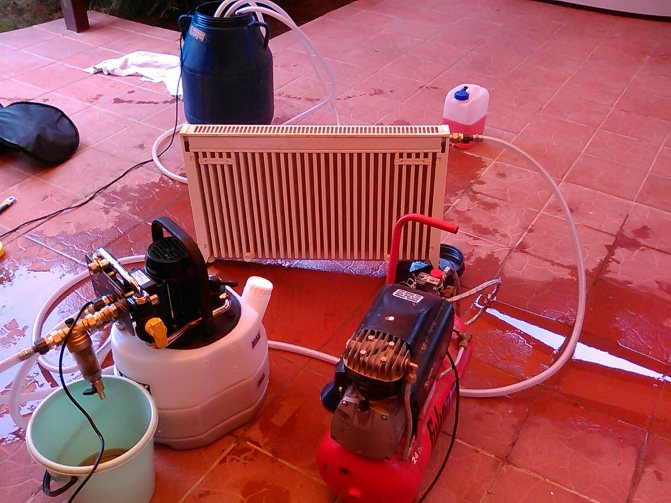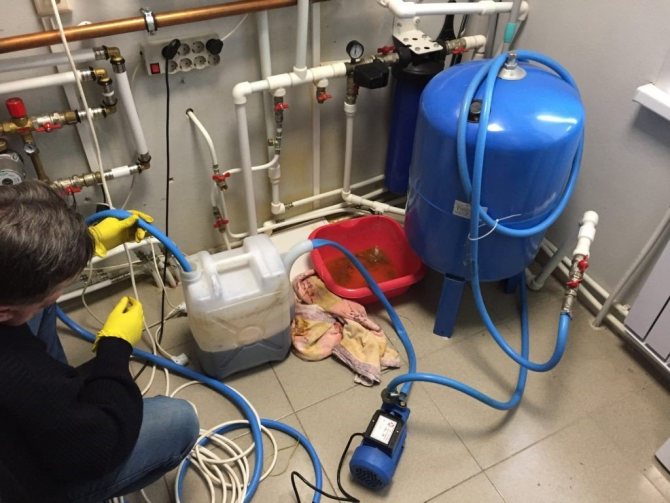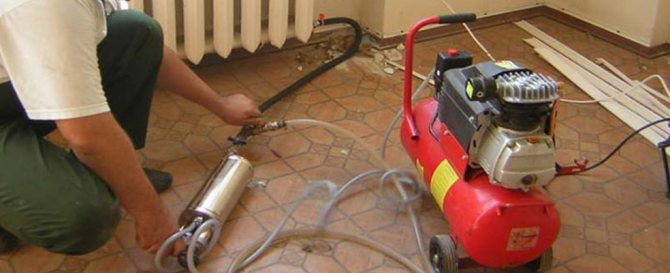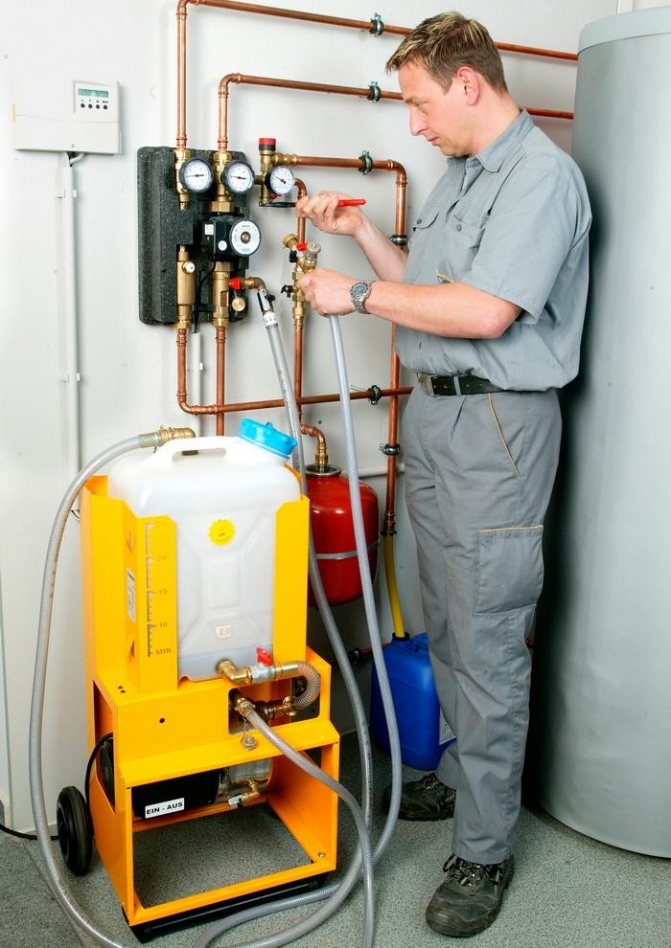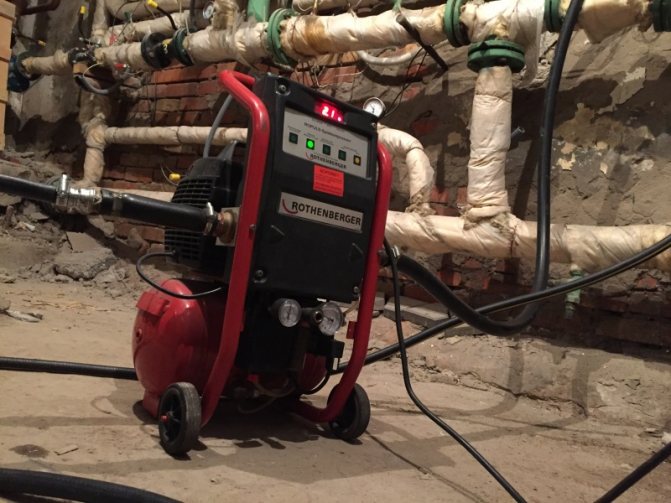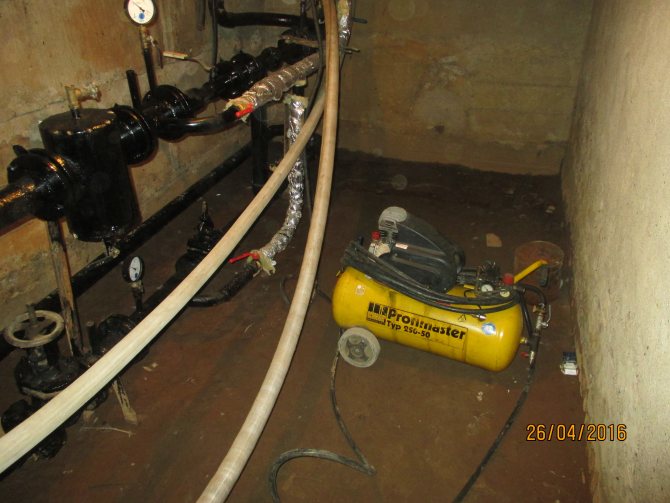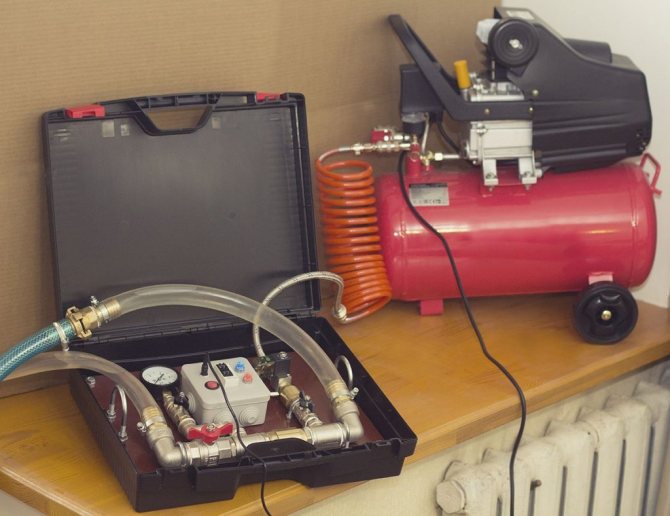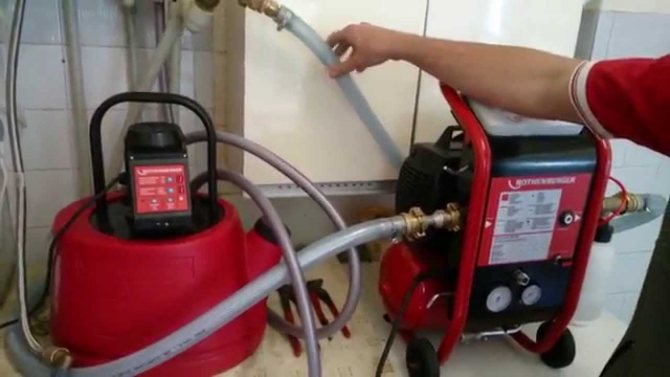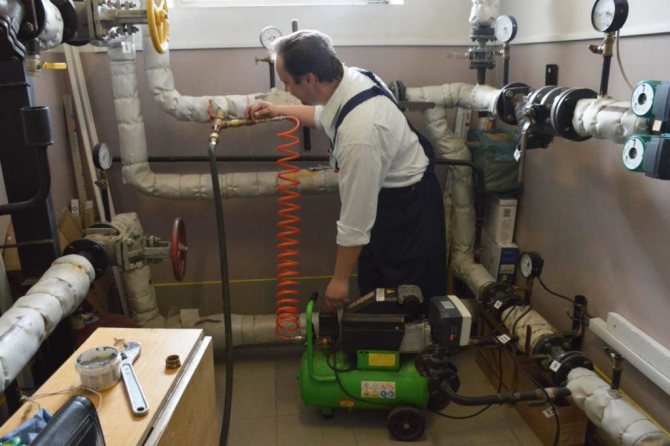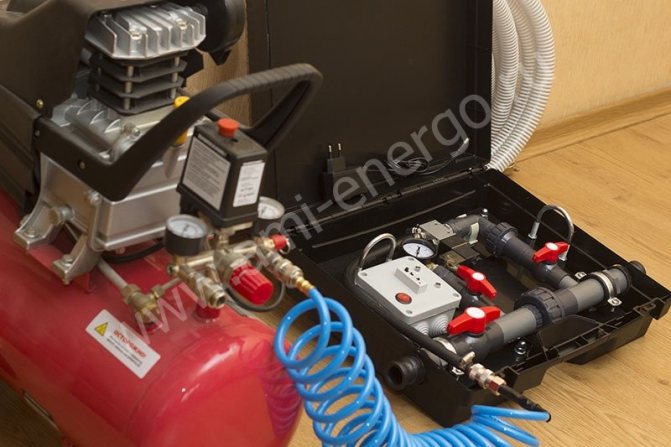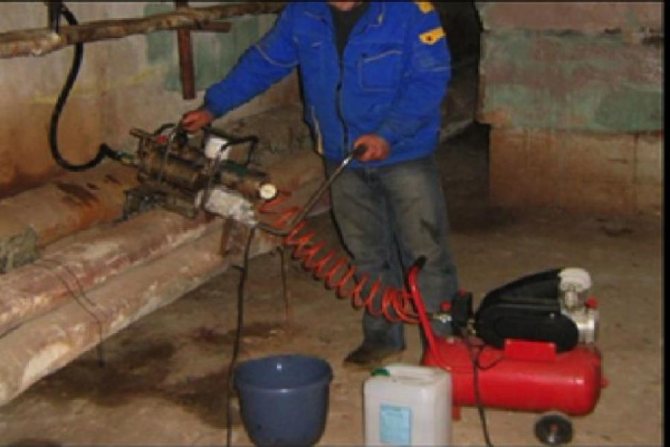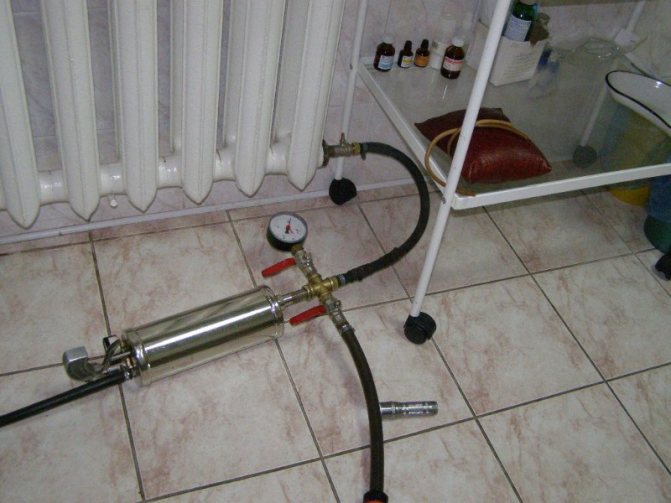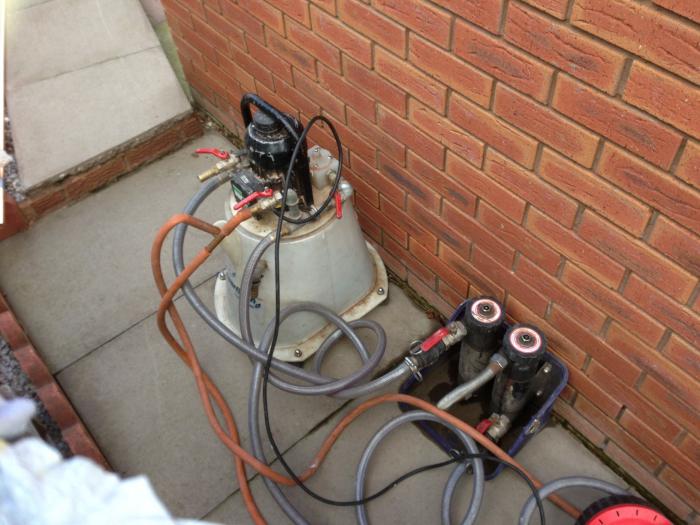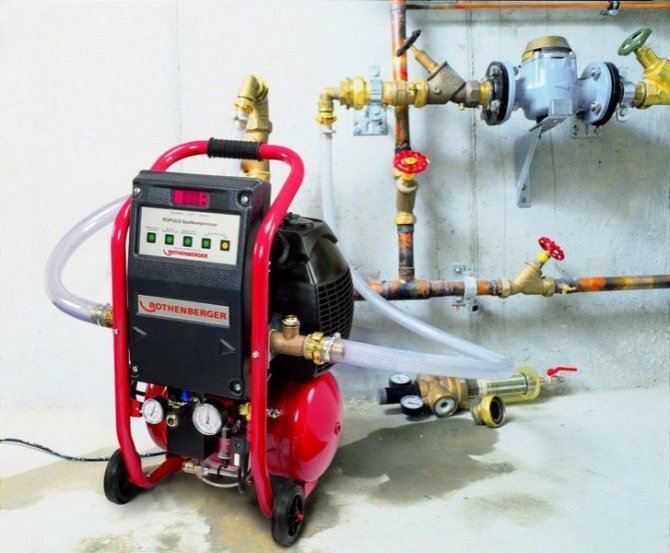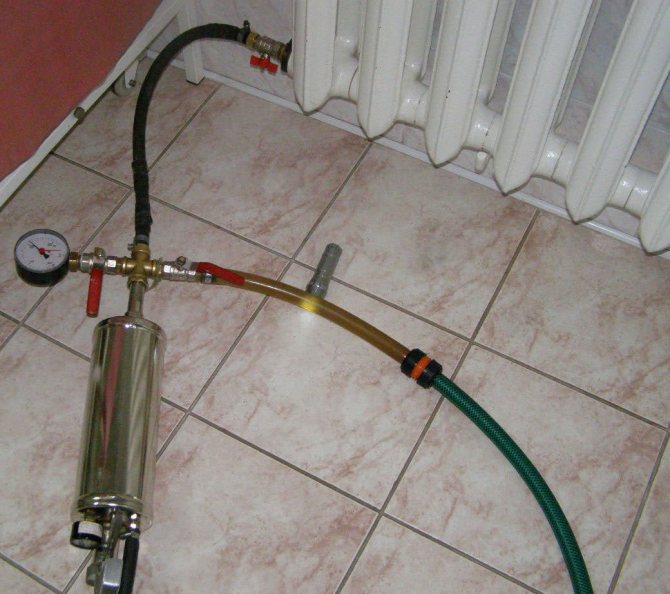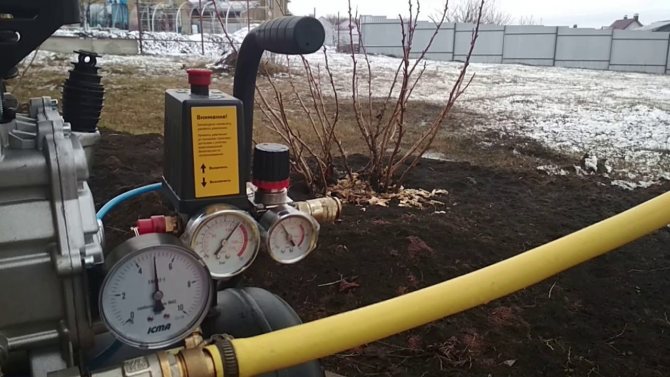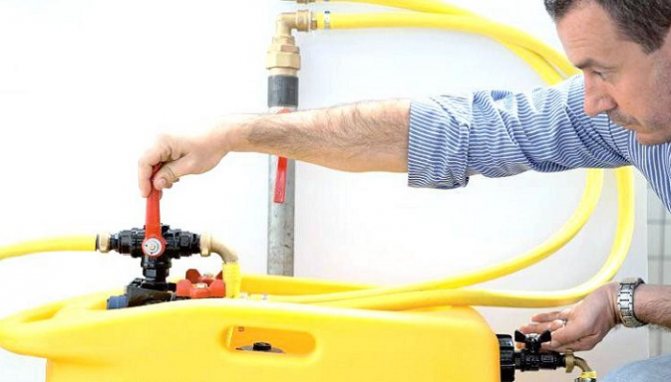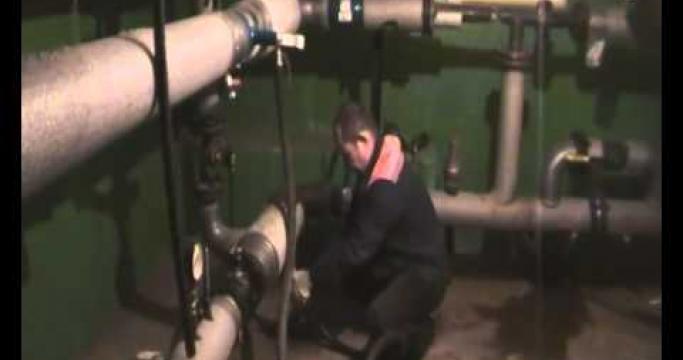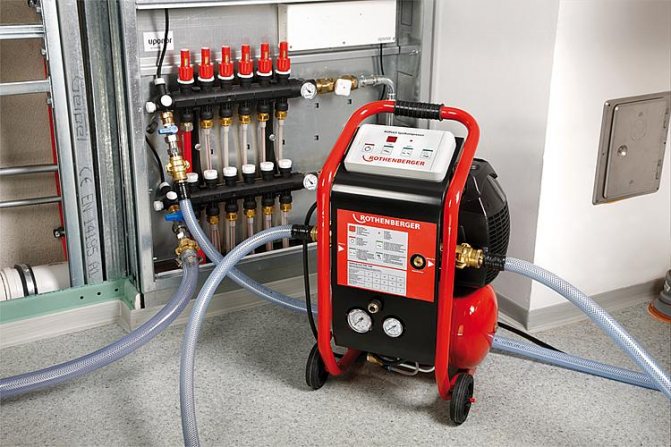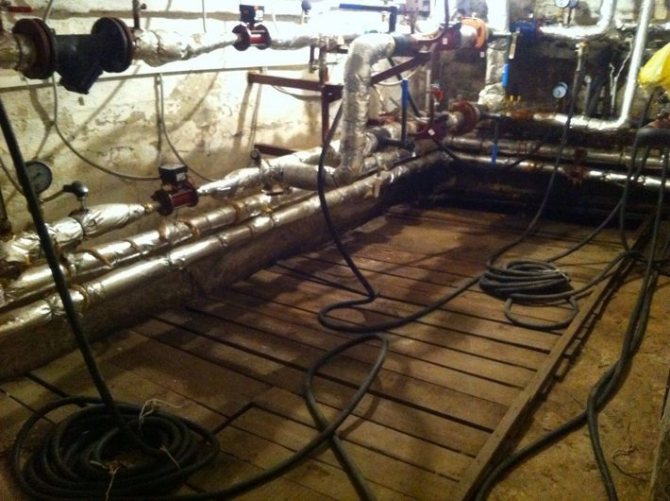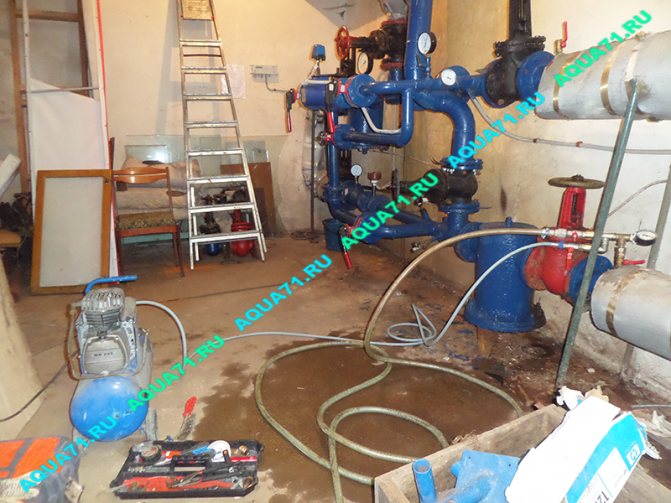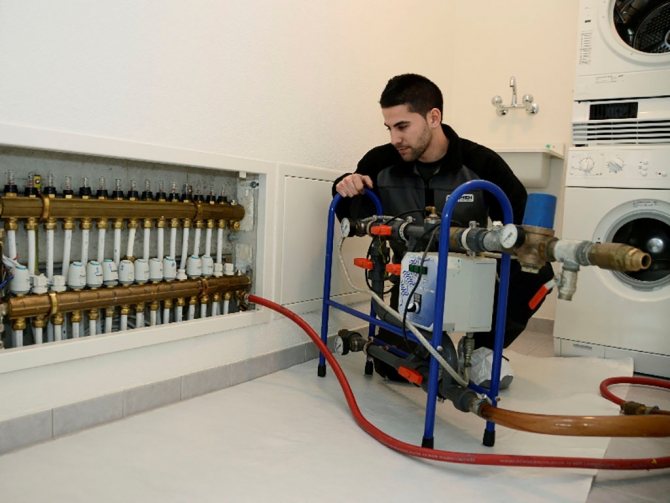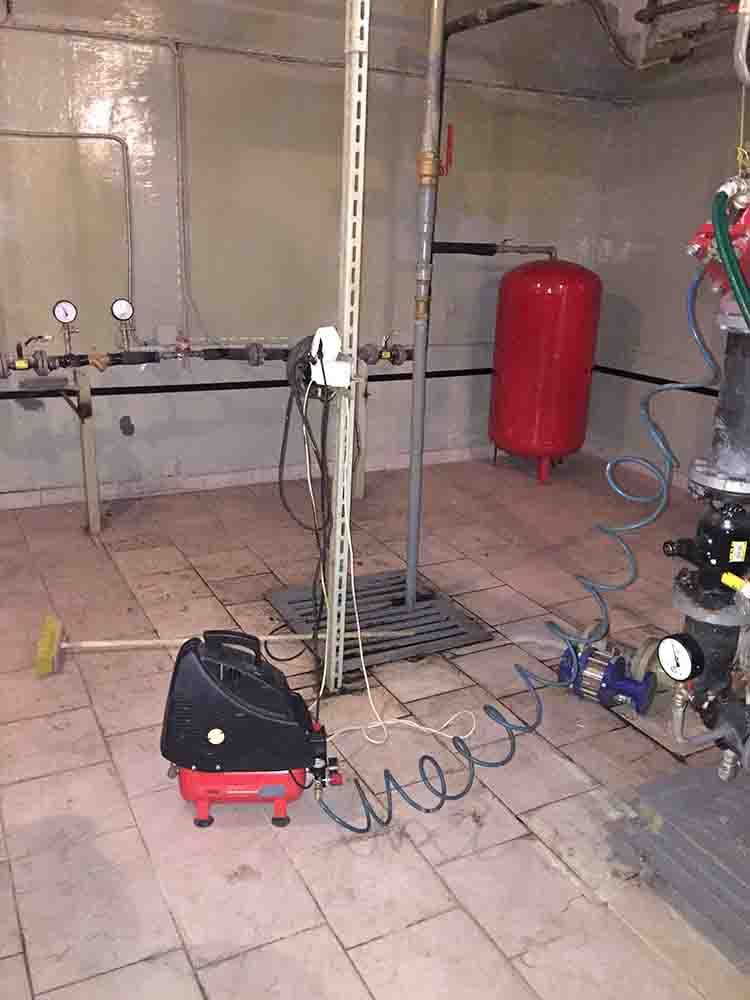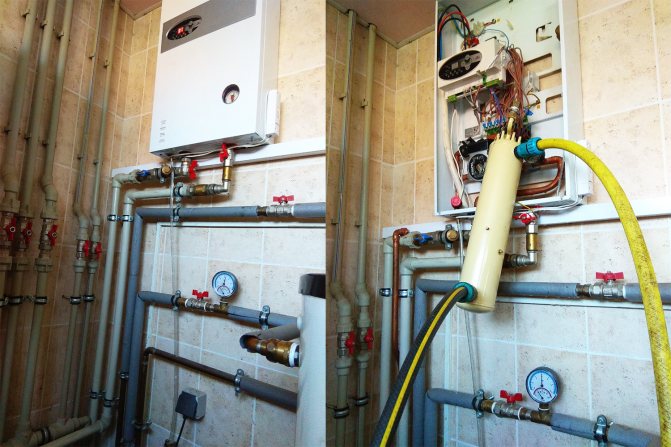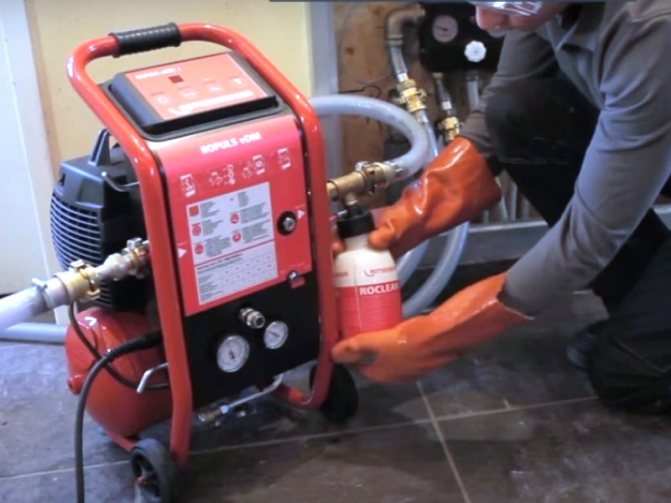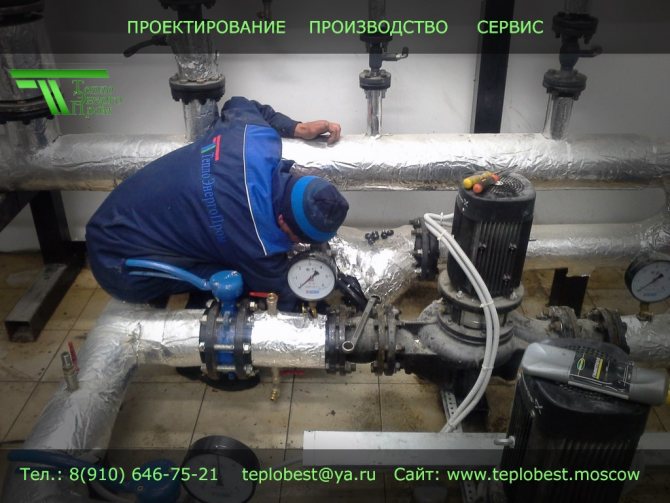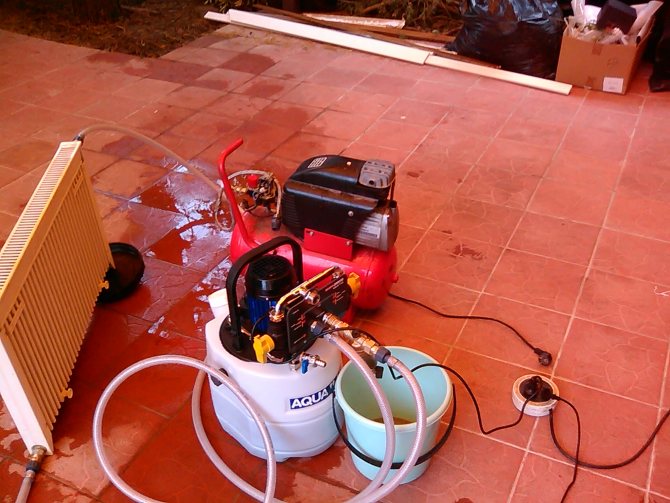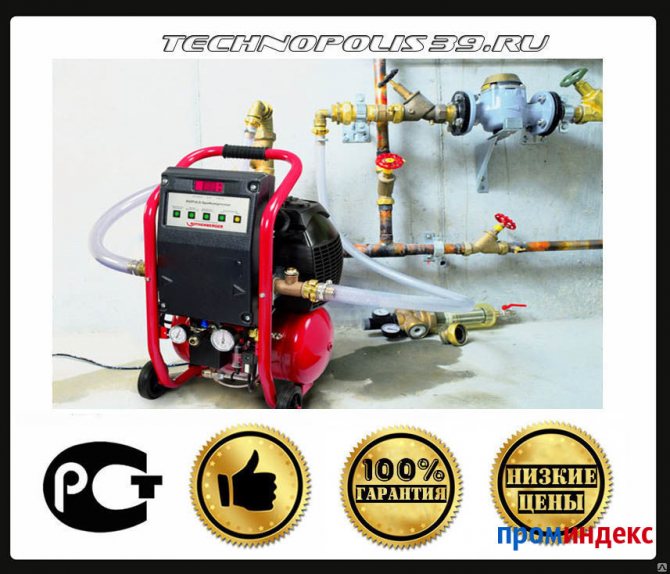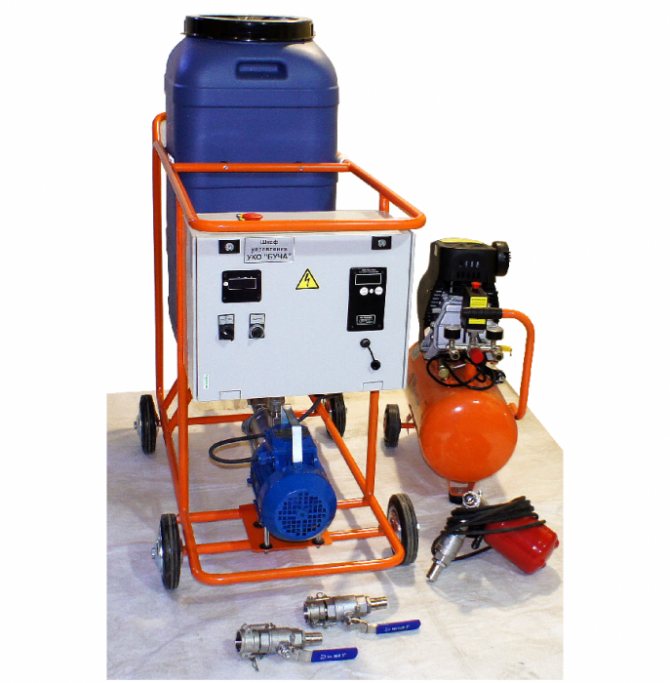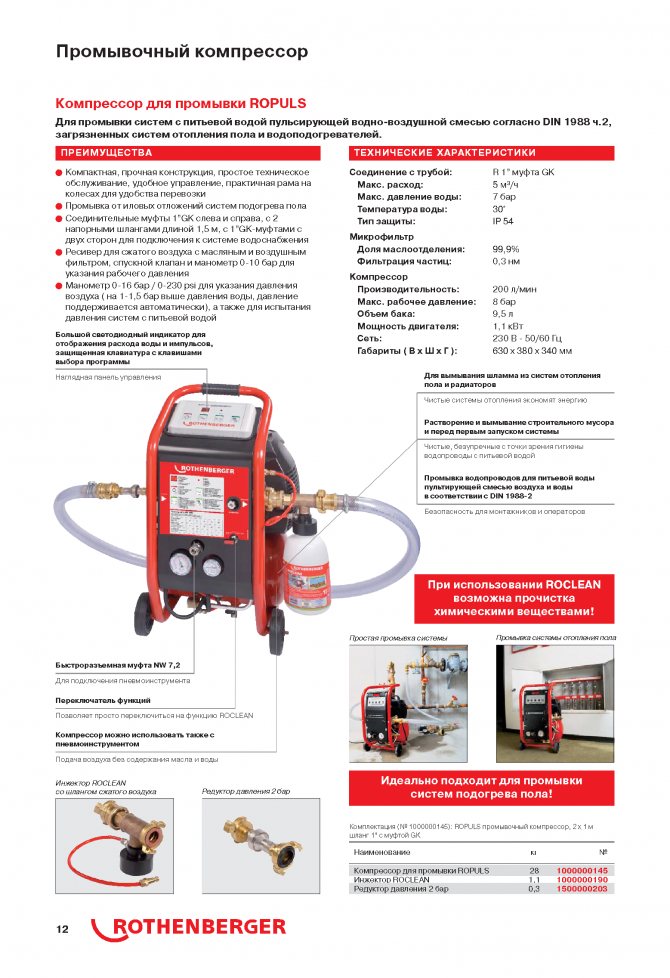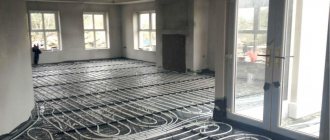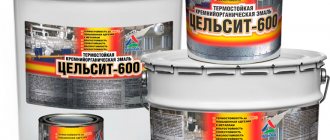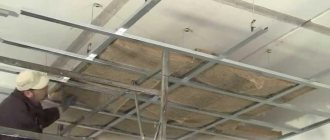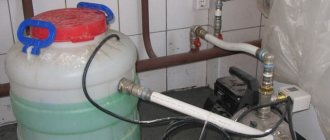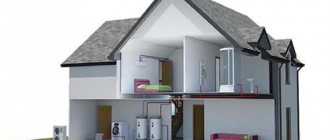SP-OM
The complex tool of the SP-OM brand is used for flushing the heating system, heat exchangers, boilers and any other heat exchange equipment. It can be used in open and closed heat exchange circuits. "SP-OM" does not destroy aluminum, polymer elements of the system, as well as rubber gaskets. It has proven itself on an industrial scale. There are various brands of SP-OM designed for specific operating conditions. Manufacturer's website - https://spomcom.ru/
SP-OM Pros
- effective removal of scale, rust and other deposits;
- in-place flushing;
- does not corrode rubber gaskets and seals;
- prevents corrosion of ferrous metals;
- may additionally include a corrosion inhibitor;
- can be used with aluminum parts.
Minuses
consultation and the services of a flushing specialist may be required.
SP-OM
Metalin T is a product based on hydrochloric acid. Removes heavy limescale deposits, rust products and organic matter in heating systems made of steel or non-ferrous metals. It is a non-flammable substance. After adding an alkaline neutralizer, it is allowed to drain the waste into the sewer. It is packed in concentrated form in containers from 1 to 30 liters.
Metalin T Pros
- non-combustible;
- fast cleansing.
Minuses
- after neutralization with alkali, discharge into the sewer system is allowed;
- not used for surface treatment of aluminum and its alloys.
It is used in the treatment of pressure boilers, tubular heat exchangers, boilers, condensers, pipelines in industry and domestic conditions. Removes various types of dirt, in particular limestone and corrosive deposits. Ideal for flushing plastic, metal, rubber pipes. Gently cleans, does not adversely affect the structure of the seals. Not recommended for cleaning systems with surfaces made of aluminum and derived alloys. A preliminary test on stainless steel coatings to be treated is also recommended.
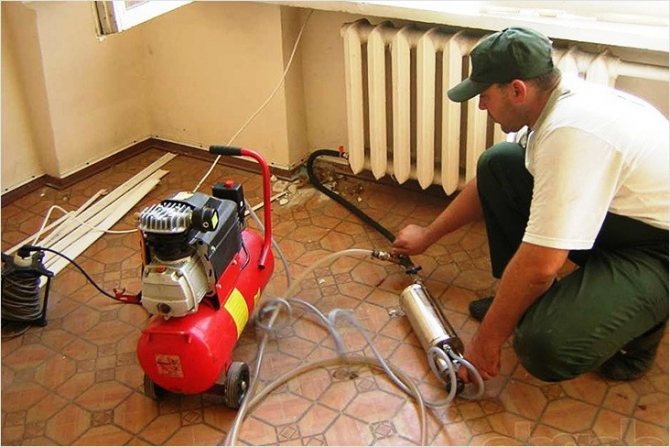
SYNTILOR Watesup Pros
- does not affect the structure of metals;
- concentrated product;
- high efficiency even at low temperatures of use (20–35 ° С);
- does not damage seals and rubber gaskets;
- contains an inhibitor.
Minuses
can not be used for products made of aluminum and derived alloys.
SYNTILOR Watesup Heating System Flushing Agent
Deoxyl-3
Deoxyl-3 is an acid-type agent for chemical cleaning of pipelines in heating and water supply systems. It is packed in the form of a concentrate in containers of 20 liters. The liquid is not flammable, belongs to the 3rd class of toxicity. For a greater cleaning effect, it is desirable to use the "Deoxil HO" additive together with the preparation. Foaming is neutralized by the Foral PG additive. The liquid is quite aggressive, therefore, in the process of working with it, it is recommended to protect the skin and respiratory organs with protective equipment. Use strictly according to the directions on the label.
Deoxil-3 Pros
- completely removes scale and corrosion deposits, regardless of the design features of the equipment;
- biodegradable;
- after flushing, the spent working solution can be drained into the sewer;
- the composition includes various inhibitors that prevent metal etching and the appearance of corrosion foci. Inhibitors allow not only to wash off deposits, but also to protect the metal.
Minuses
the liquid is aggressive (work with it only with protective equipment).
What would you choose from a system flush or recommend to purchase?
Deoxyl-3
75.00 % ( 3 )
Save your voting results so you don't forget!
To see the results, you need to vote
Do-it-yourself heating flushing mechanically
For self-cleaning of radiators, mechanical cleaning technology is most applicable. In this case, you do not have to use any special equipment or specific chemicals.
Before you rinse the gas boiler heat exchanger with your own hands, you should prepare the necessary materials:
- rags or old thick clothing. With their help, it will be possible to protect the bath from damage during the process of flushing radiators in it;
- fum tape or sanitary flax with a tube of sealing paste;
- a branch pipe that allows you to connect the hose to threaded connections.
From the equipment you will need the following:
- two hoses;
- a set of keys;
- corset;
- steel wire ruff;
- buckets, basin and rags.
The actual cleaning of the heat exchanger and lines consists of several stages.
- A hose of the appropriate diameter is connected to the drain pipe of the heating system. The other end of the hose is led down the drain.
- A second hose is connected to the highest point of the system. As a rule, such a point is either a branch to an expansion tank or a safety group. The tank or safety group is unscrewed and in their place a branch pipe is screwed onto which the hose is put on. The other end of the hose is connected to the water supply.
- When everything is ready, water is supplied to the system. This way it is possible to get rid of scale and dirt deposited in the lines of the system.
- The coolant is being drained. To do this, remove the hose through which tap water was supplied. In this case, the connection to the system is not blocked. Under the influence of gravity, water begins to drain through the drain pipe at the lowest point of the line.
To completely drain the coolant, make sure that the outlet end of the hose is below the level of the heating system lines. In a private house, it will be possible to provide such a configuration if water is drained into buckets installed in the underground.
Radiators are removed from the dehydrated system
Be careful when doing this. It is likely that the threaded connections on them have coked up and you will have to make some effort, trying not to damage the threads. The removed radiators are transferred to the bath, previously covered with a rag or thick cloth
Here they are washed with running water, treated with a brush and a steel wire brush. After flushing the radiator, it is carefully inspected again for any remaining contamination. The radiators are installed in place.


df2185cefce037de2f4f59e24c82a23a.jpe
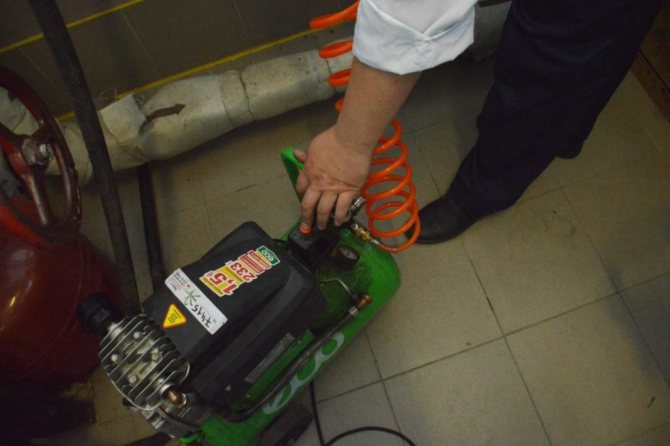

eea5416a8dab45beb5327b9907898e97.jpe
- Through the drain pipe, the lines are filled with fresh water. At the same time, the formation of air jams in the pipe and radiators is monitored. You can get rid of air bubbles by opening the Mayevsky taps on the radiators. As soon as the air stops hissing and water begins to ooze from the tap, it closes them. As the lines fill up, it is advisable to repeat this procedure several times.
- After the actual flushing of the gas boiler heat exchanger with your own hands is completed, the heating system is started up.
- With the beginning of the circulation of the coolant, re-formation of air locks in the radiators is possible. To eliminate them, the Mayevsky cranes are re-manipulated. Part of the air will be removed on its own through the air vent.
- As the pipelines and radiators become free of air, the pressure of the coolant will drop. To level it, it is necessary to make additional pumping of water from the water supply system.In addition, the pressure in the expansion vessel should be checked.
How is the pressure test carried out?
After carrying out the hydropneumatic flushing, and indeed before each heating season in the autonomous heating system, it is necessary to check the tightness and carry out routine maintenance to increase the tightness of the pipeline connections. Day after day, the connections of your heating system wear out and in order not to get an accident with a breakthrough in the cold season of the sled, that is, the tightness of the pipes must be prepared in advance. This operation is called crimping.
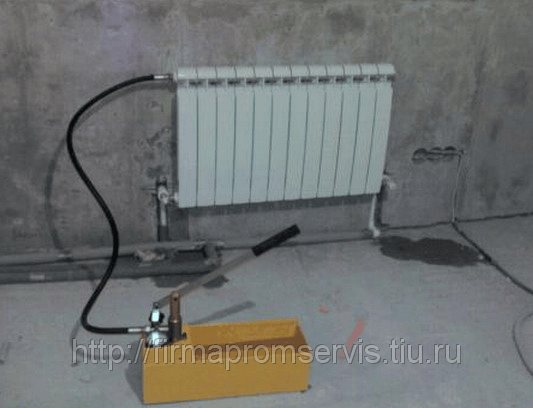

heating radiator pressure testing
Note that in extreme cases, pressure testing can also be performed during the heating seasons, usually such an operation is performed after pipeline accidents. In addition, pressure testing and monitoring of the state of pipeline connections are also carried out at the first start-up of the system after its installation.
The production process of crimping the joints of heating system pipelines consists of the following stages:
Fill the system slowly with cold water. Please note that the pressure in the system must be increased gradually, not in jumps. The fluid pressure level in the system is monitored using a pressure gauge. When the operating pressure of the system is reached, it remains under pressure for about half an hour. During this time, you can visually check the condition of the pipelines and their connections, make sure that there is not only a leak, but even the slightest leakage of water. The easiest way to control the leaking moisture is to place pieces of toilet paper or napkins under the joints, on which drops of water or sludge are clearly visible.
In addition, the state of the system is monitored by the readings of the pressure gauge. This is done because pipelines can also leak in places inaccessible to visual control. If there is no pressure drop according to the pressure gauge and there are visual signs of damage to pipes and the system, you can start operating it. For additional confidence, the pressure in the system can be increased 10-15 percent above the calculated one.
Heating system flushing instructions
Pneumatic pulse cleaning scheme
There are 2 main methods of flushing the heating system, namely:
- using special hydropneumatic equipment;
- using chemical reagents.
Hydropneumatic flushing
Hydropneumatic flushing of heating systems - instruction Hydropneumatic flushing of heating systems - instruction
This method is actively used by domestic housing offices and is quite effective. You just need to do everything in accordance with the technology.
The principle is extremely simple: first, water is discharged from the system, then it is fed back. A special pneumatic pump is used to "adjust" the water flow. As a result, under the influence of a rather powerful pressure, scale and other deposits peel off, and when the water is drained, they are removed from the system.
To carry out such a procedure on your own, you will need a pneumatic pump capable of pumping a pressure of more than 6 kg / cm2.
The sequence of actions is as follows.
Before starting work, you need to turn off all the taps
First step. We close the "return" valve.
Heating system lines diagram
Second step. We connect the pneumatic pump to the valve installed after the valve.
Step three. We reset the "return".
Fourth step. We give the pneumatic pump to pressurize above 6 kg / cm2, and then open the valve to which it is connected.
Fifth step. We shut off all the risers one by one. We do this so that no more than 10 risers are blocked at one moment.Compliance with this rule will make the flushing procedure as efficient as possible.
Sixth step. We transfer the system to dropping in the opposite direction. To do this, do the following:
- close the discharge and close the valve connected to the pump and turn off the device;
- close the open valve, and then open a similar one on the "return";
- we reset the heating system. To do this, connect the pneumatic pump to the valve in the opposite direction, then open the valve and turn on the pump. The fluid will move in a different direction.
You can determine the required duration of flushing "by eye". A clear, clear liquid started to come out of the system? You can finish! Return the gate valves and valves to their original position and turn off the pump.
Prepare a suitable container to collect dirty water. If you wish, you can connect a hose to the battery and ensure that the dirty coolant is drained into the sewer.
Chemical washing
Scheme of chemical pipe flushing
This method can be used only in two cases, namely:
- if it is necessary to clean the heating system with natural circulation, built with the use of steel pipes. It is advisable to use chemical reagents in situations where, for any reason, there is no desire to flush the entire system. Most often, blockages are deposited in heat exchangers. The system can get silted up along the entire perimeter. In the second case, there will be no special sense from chemical washing;
- if it is necessary to restore the old heating system. Over decades of operation, pipes can become clogged and overgrown so that the power of the pneumatic pump will not be enough for effective cleaning. You could, of course, take a more powerful pump, but no one will give guarantees that the pipes will not burst under such a pressure.
Reagent for washing
The principle of flushing is simple: instead of a coolant, a special solution containing acid and alkali is poured into the system. Then the mixture is circulated for 2-3 hours (if the line with natural circulation is not cleaned, for this it will be necessary to connect a pneumatic pump), after which it is drained and the pipes are filled with a standard coolant.
Reagents for flushing and protection of heating systems
Never use such chemical mixtures for cleaning aluminum pipes. If the products remain intact after such a rinse, they will serve much less.
It is recommended to flush the system of a private house at least once every 7 to 10 years.
Act on flushing and pressure testing of the heating system
Drawing up an act on the performance of work summarizes the procedure for flushing, hydraulic testing of the heating circuit of a multi-storey building. Properly carried out cleaning will allow the artificial heating of the house communications to work the next season.
The act of flushing and pressure testing the heating system, a sample of which is given below, contains the following information:
- the address of the location of the communication, its type - open, closed;
- cleaning method;
- materials, their volume, quantity;
- date of work;
- analysis.
At the bottom of the document are the signatures of the contractors - the customer and the contractor.
The heat consumption system flushing certificate form can be downloaded here.
Flushing the heating systems of an apartment building
Flushing of heating systems in apartment buildings can be done by the following methods:
Chemical rinsing
This method of purification consists in supplying special chemical reagents in the form of alkalis to the system.
Then, due to special pumping equipment, a continuous circulation of the liquid is carried out for several hours. After that, the solution is completely drained and the system is pressurized.
Hydropneumatic flushing
This flushing method is very often used when cleaning heating systems in apartment buildings. The effectiveness of flushing depends on the correct cleaning job.
Algorithm of actions for hydropneumatic flushing:
Shut-off of the valve in the return pipeline. Connecting the compressor to a metering valve in the flow after the house valve. After the pressure in the ballast tank of the compressor reaches the level of 6 kgf / cm2, it is necessary to open the valve to which the compressor is connected. Then you need to close the risers
It is very important that no more than ten risers are open during the overlap. This will ensure that all risers and radiators connected to them are flushed efficiently.
Duration - this flushing can be determined independently - if the liquid in the riser becomes transparent, then you can start flushing the next pipe.
At the last stage of cleaning, you need to correctly switch the heating to reset in the opposite direction:
- To begin with, the discharge and the valve are closed.
- Then the house valve closes at the feed, it opens during processing.
- Ultimately, the discharge from the serve opens. The compressor must be connected to a metering valve in the return line. After that, you need to open the compressor.
What is water flushing
This method of cleaning heating systems consists in the simultaneous supply of water and a certain amount of air under pressure to the pipelines. Cleaning of communications with a water-air mixture occurs due to multiple impulses emitted by the compressor. They create small bubbles in the water, which gradually wash away the deposits on the pipe walls.
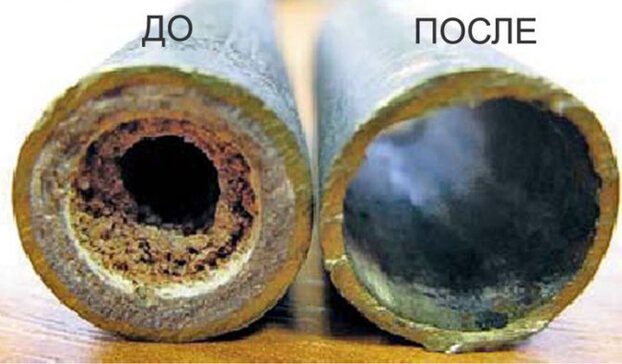

In order for the hydropneumatic flushing of pipelines to be successful, it is necessary to perform calculations of a number of parameters and find out:
- the length of the pipes to be flushed;
- water speed;
- air flow and pressure (determined based on the diameter of the pipes).
To obtain the required speed of movement of the water-air mixture, the communications should be flushed in separate sections - along the risers or their groups.
Do-it-yourself chemical washing
For chemical cleaning, it is important to select the correct product and carefully study the instructions before starting work. For self-cleaning of the heating system in a private house, you need:
- pump;
- container for liquid;
- cleaning agent;
- hoses.
Most chemicals are diluted with a certain volume of water before use. If desired, you can purchase ready-made liquid in stores, which is the best option for flushing a small system. For large stand-alone systems it is recommended to purchase a concentrate. The cleaning procedure is as follows:
- drainage of water from the heating network;
- filling the tank of the treatment plant with the prepared composition;
- switching on using the pump nozzles and filling the heating system elements with a chemical composition.
Usually 2-3 hours are enough for the destruction of scale. The circulation is carried out until there are no deposits in the filter tank. Flushing of the heating system with water is mandatory to completely remove the chemical reagent
Please note that the spent chemical solution must not be disposed of down the drain
When carrying out work, pay attention to the precautions with the chemical. Precautions:
- when working with a solution, it is imperative to wear gloves;
- the concentration of the reagent can be very dangerous for humans, therefore, before starting work, it is necessary to protect the mucous membranes with a respirator.
The main advantages of this method are
- High-quality removal of limescale and rust on the inner surface of pipes.
- No need to completely dismantle the heating system.
- Uniform heating of radiators after flushing.
- Reduced fuel consumption and, as a result, savings.
- Extending the life of the heating system.
Heating system flushing frequency
According to SNiP, flushing of the system is required annually. But cleansing is carried out of different types. Conventional hydraulic is carried out annually, with the addition of air - once every 2-3 years, and chemical - as needed, but not more often than once every 5-7 years.
How far the operating organizations adhere to such recommendations is difficult to say. But in individual systems, no one bothers to flush the heating system every two to three years. There is no need for annual processing. After the end of the season, you can drain some of the coolant to assess its condition. If there are no "aromas" and no precipitation, it is not yet time to flush the heating.
Why flush the heating system?
Scale accumulating on the walls of the pipes of the batteries causes numerous problems. First, the mechanical wear of pipes is significantly accelerated. Secondly, the heat transfer of the system is significantly reduced, and this is a negative factor. So, experts say that scale 1 mm thick reduces the level of heat transfer by 15%, because thermal conductivity of scale is approximately forty times less than similar parameters of metal. This indicates that even a thin layer of scale damages the metal and can lead to fistulas and rupture of pipes.
In addition, key heating indicators change in the negative direction. This means that fuel costs go up and efficiency goes down. As you can see, the consequences are significant, so flushing heating pipelines and radiators is extremely necessary.
The above can be summarized as follows: the main purpose of flushing heating is to achieve maximum savings in heat and money for the consumer. It must be clearly understood that pipes clogged with various deposits often cause emergencies. Ideally, heating radiators and pipelines should be flushed once a year.
Before performing a range of work, you should diagnose the system. The obtained indicators will show the specialist the complete picture, that is, he will recognize the composition and nature of the deposits. Based on the results, the appropriate equipment will be selected, and after flushing, it is necessary to perform anti-corrosion treatment of the pipe walls. Thanks to this procedure, the appearance of deposits and scale is prevented for a while.
The ways
Typically, flushing is done in the following ways:
- Water-pulsating mixture. This flushing method is carried out using pulsating water and compressed air. Due to this, sediments, rust, plaque, silt, sand are removed in the pipes. This flushing method reduces energy costs and extends the life of the heating system elements. However, special equipment must be used to carry out this flushing.
- Biologicals. The use of biological products during flushing ensures deep penetration into clogged areas and complete dissolution of all deposits. When flushing with biological products, it is not necessary to turn off the entire heating system. Water-based supercleaners are mainly used as biological products. The principle of action of these drugs is based on loosening scale, oil-mud, hard crystalline, corrosive and organic deposits.
- Pneumohydroimpact. During flushing in this way, special equipment is used. This method is very convenient since you do not need to disassemble the battery components. Also, there is no need to use special cables and chemicals. With the help of the equipment, a pneumohydraulic impulse is supplied to the system. The main blow falls on the main column of the coolant with deposits. Due to this, the deposits quickly break down and dissolve. The efficiency of this method is very high.In addition, ruptures and cracks in pipes are excluded.
- Chemicals. This cleansing method is based on the use of preparations containing organic and inorganic acids. The preparations, getting into the pipe, completely dissolve scale, rust, and deposits in the form of salts.
Hydropneumatic flushing steps
Our company, which carries out high-quality flushing of any pipeline systems, performs this procedure in the following sequence:
- inspection of the pipeline, determination of the level of complexity of work;
- insertion of special pumps into the system;
- circulation of the transported liquid for a certain time under the maximum pressure pumped by the pumping equipment;
- disassembly of tank equipment and pumps;
- determination of the quality of cleaning. For this, a small section of the pipeline is cut out to detect deposits and scale.
The advantages of using this method include an almost complete restoration of the throughput of pipes, a decrease in electricity costs necessary to ensure the circulation of water or its transportation in water supply systems. Also, in heating networks, the cost of heat loss is significantly reduced. The availability of all the necessary equipment in our company, extensive experience in this field of activity allows us to flush pipelines in the shortest possible time, as well as guarantee high efficiency of their work.
Instructions for carrying out hydropneumatic flushing
- Remove the nozzles and diaphragms from the hydraulic elevator, if available in the system.
- Drain the circuit down the drain to drain the contaminated water.
- Conduct a thermal imaging survey of the internal surfaces of the radiators if special equipment is available.
- Close the heat valve located on the "return" pipe.
- Fill the system with water to remove air from it, with the air collector valve open. As soon as the system is full, the valve is closed.
- Connect the compressor to the metering valve, open the “return” drain.
- Open the valve when the pressure on the compressor reaches 0.6 MPa;
- Close the risers and flush them one at a time. Flush until purified water flows out of the hose.
- Switch the heating circuit from supply to return. Flush all risers in the opposite direction.
After completing the flushing process, the system must be filled with water, as its pipes must not be kept empty.
Why is regular maintenance essential?
In addition to emergencies, the accumulation of scale in the pipeline heating system also sharply reduces its efficiency. So, just a millimeter of scale on the inner surface of a heating radiator reduces its heat transfer by 15 percent. Accordingly, in order to achieve a normal temperature in the house, you will have to increase the power of the boiler, and therefore increase fuel costs. In order not to incur extra costs, you need to clean the system.
The build up of scale on the internal surfaces of the system has a much lower thermal conductivity than conventional pipe metal. Scale is essentially a heat insulator - its thermal conductivity index is 40 times less than that of metal. Even a thin layer of limescale reduces the efficiency of the heating system to minimum values. Moreover, the scale enters into active interaction with the pipe metal, which leads to increased corrosion, and even to the formation of fistulas.
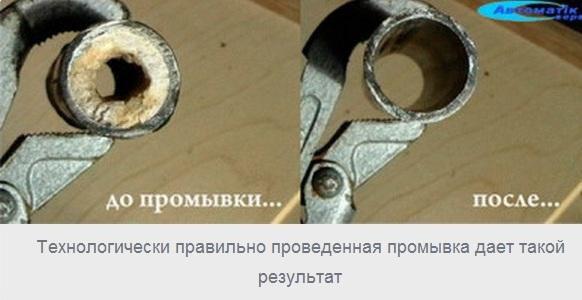

Before and after rinsing
In order to improve the quality of the heating system, it is not necessary to wait for emergencies. Such work must be carried out regularly, usually at least once a year.
Hydropneumatic flushing of heating systems - instruction
- Flushing of the heating system is carried out in the presence of a representative of the power supply organization.
- The foreman of the district heating unit is invited to the start of flushing, and in his presence, flushing work begins.
- At the time of flushing, the heating system is disconnected from the quarter heating network by valves 1, 2, 3, 4. If the closure tightness is not enough in the valves, additional blinds (plugs) must be installed, made of 3mm sheet steel.
- By the beginning of the new heating season, these valves must be revised.
Preparatory work
Rubber hoses are connected to the flushing fittings. Hoses (rubber hoses) are connected using ROT half-nuts (according to GOST 2217-76). Check valves must be installed on the air and water inlets, which will be used for flushing.
Remove the nozzle from the elevator before flushing.
- The system is filled with cold water through a valve 19 with an open valve 21 of the air collector and open valves 22 and 24, as well as closed valves 1; 2; 3; 4; 18; 20 and 23. After water appears in the valve 21, this valve and valve 19 must be closed.
- Purge air on each riser in the heating system.
- To do this, close all 24 valves on the risers. Open the air valve 18. By sequentially opening the valves 22 on the heating risers, the risers are purged with air from the bottom up.
- To drain the waste water after the stormwater drainage system, a flexible rubber hose must be put on the fitting 20.
- Starting from the far riser, all risers are hydropneumatically flushed sequentially.
- To do this, open the valve 22 and 24 in succession on the risers with the air valve 21 open, then open the water valve 19 and air valve 18.
Then to carry out flushing
- consistently fill the risers with water;
- close taps 21 and 23;
- open the water drainage through the 20th valve.
Turn on the air with the valve 18. With the valves 19 and 20 open, turn on the risers in series, opening the valves 24, starting from the farthest riser.
Hydropneumatic flushing technology
- Inspection of the system (the degree of clogging of the system with deposits);
- Integration of pumping equipment into the existing system;
- Forced circulation in the system of high pressure water during the specified time;
- Dismantling of pumping and storage equipment;
- Quality control of flushing by cutting pipe sections;
- Pressure testing with prepared water.
How often is hydropnematic flushing done?
- Once a year (inter-heating period).
Act of hydropneumatic flushing of the heating system
In centralized heat supply systems, after the flushing of pipes and heating devices is completed, an act of hydropneumatic flushing of the heating system is drawn up.
Hydrodynamic type of flushing
The scheme for flushing heating in a similar way involves an active effect of water on scale and deposits. This happens due to a stream of water, which is directed to the desired area under strong pressure.
Water is supplied through special nozzles of the required size and diameter. This type of washing is more expensive than chemical washing, but the result is much more satisfactory.
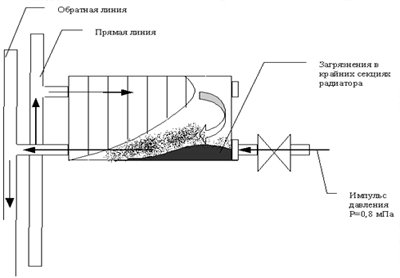

Scheme of using the hydrodynamic method of cleaning the heating system. Click to enlarge.
This type of flushing is best suited for batteries made of cast iron. Removing scale from cast iron using chemicals is very problematic due to the properties of the material itself, and sometimes even impossible.
However, the hydrodynamic system does an excellent job in such cases.
Another undoubted plus is the environmental friendliness of such washing, since no acids and solvents are used. But only water.
To achieve the desired effect, specialists must have a special mechanism that will create a pressure of two hundred or more atmospheres.
Naturally, all scale is removed exclusively by exposure to water. No additional fluids or reagents are needed.
But here, too, everything is not as simple as it seems. Before flushing with this method, it is necessary to take the radiator to a service. There it will have to be treated with a special liquid so that the layer that needs to be removed becomes softer and more pliable.
Only then can the walls be treated with a pressurized water jet. Using this method, you can remove almost everything: grease, scale, rust, dyes, carbon deposits, etc.
Flushing Signs
For the normal functionality of the heating system, nothing should interfere with the movement of the coolant through the channels built for it.
It can be diagnosed by carefully monitoring the operation of the entire system and the appearance of a number of indirect signs:
- the system warms up longer than before (for autonomous heating systems);
- the operation of the boiler is accompanied by sounds uncharacteristic for it;
- increased consumption of gas or electricity; the temperature in different parts of the radiators varies significantly;
- radiators are noticeably cooler than the supply pipes.
However, weak or uneven heating of batteries is not always a sign of clogging. Perhaps they were airborne. In such a situation, it is enough to dump the airlock through the Mayevsky crane.
In houses with a centralized heating system, it should be flushed by employees of the heating company. In a private house, this procedure is carried out by the owners or invited specialists.
For example, in district heating systems, the coolant must go through a water treatment cycle, which reduces the degree of pollution. True, this rule is not always fulfilled. And the system itself has often been in operation for the third or fourth decade and the amount of garbage circulating inside increases every year.
But for both centralized networks and stand-alone systems, it is recommended to flush annually. Which, by the way, is confirmed by the requirements of building codes. It is this period that is considered critical for the accumulation of the amount of debris inside the circuit, which significantly reduces the efficiency of work.
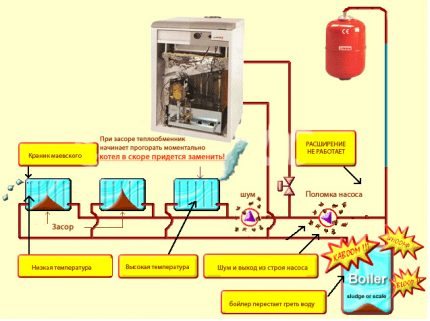

If the system is not flushed before the start of the heating season, the pipeline is clogged, devices and heating equipment fail prematurely
Is it possible to do without flushing
The coolant entering the central heating system is much more often of poor quality. As a result, scale builds up on the walls of radiators and pipes, which then becomes a huge source of trouble.
It is possible to single out from them:
- the service life of pipelines is significantly reduced due to their mechanical wear;
- the system ceases to effectively release heat energy into the surrounding atmosphere of the room... For example, 1 mm of scale is practically able to reduce the heat transfer of the radiator by 15%, since its thermal conductivity is 40 times less than the iron surface. Because of it, the latter is damaged, which can lead to the formation of fistulas and damage to the pipes;
- other negative factors should not be overlooked, for example, a decrease in key heating indicators, which increase the cost of fuel grow with a decrease in the efficiency of the system, and its price is now high.
Proceeding from this, periodic flushing of batteries and pipelines should not be neglected, since its main purpose is a large heat recovery and consumer savings.In addition, you should understand that parts of the system clogged with various deposits often become a circumstance of emergency situations.
Tip: The perfect option is to flush heating radiators and pipelines once a year.
We recommend that you carry out system diagnostics before such work. Taking detailed indicators, the expert will notice the complete picture, which will allow him to determine the temperament and composition of the deposits.
That is why he will be able to select the appropriate equipment, and at the end of the flushing, perform anti-corrosion treatment. This prevents deposits and scale from appearing on the walls for a while.
While heading to flush
This will be indicated by indicators of a decrease in the efficiency of the heating system.
These include the following:
- in an autonomous system, unusual and unusual sounds will periodically be heard from the boiler;
- the system heats up to the optimum temperature for a long time;
- the pipelines are warm and the radiators are cold;
- there was a sharp consumption of energy sources (for personal heating), which will please few people;
- installation of a new boiler in a previously operating heating system.
Do not try to delay the taking of measures for a long time, if indicators have appeared, otherwise emergency situations may appear.
Tip: the main indicator of the ineffective operation of the heating system is the uneven heating of the pipes leading to the radiators.
Preparing for flushing
Let's take a closer look at the process:
- At the initial stage of the technology, compressed air space is fed into pipes filled with water. That is why the speed of movement of the mixture increases with the creation of high turbulence. Sediments are loosened up and begin to be removed from the system.
- Fittings with valves and check valves must be cut into the pipeline. If the system is small, water is directed to be supplied through the pipes, which are already in it. To discharge the coolant, a drain pipe is cut into the return pipeline or special taps are used. At the time when the system with the elevator is flushed, its glass and cone must first be removed.
- It is necessary to supply air space by means of a compressor for flushing the heating system, talented to create a pressure of approximately 6 atm. A check valve is installed on the compressed air pipe so that it limits the ingress of water into the equipment receiver.
Advice: use only a high-quality compressor, then you can completely clean the heating system from deposits. It is not necessary to buy equipment, it is possible to rent it.
When choosing a compressor, pay attention to its technical features. It is necessary that he was able to mechanically adjust the frequency of the pulse formation during the supply of the mixture. Great, while it is possible to add approved disinfectants.
Pay attention to the following:
- protection must be provided that will not allow the equipment to turn on spontaneously;
- it is better to choose a compact and mobile compressor;
- a prerequisite is indicators showing the pressure level and flow rate of flushing water.
Flushing process
The instructions below will help you understand the hydropneumatic method. There are two options:
| Flowing |
|
| System filling |
|
At the end of the flush:
- the hydraulic resistance in the system will decrease;
- heat transfer will increase;
- fluid circulation will improve.
Remember, for each heating system, a separate calculation of hydropneumatic flushing is performed.

